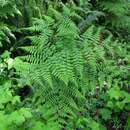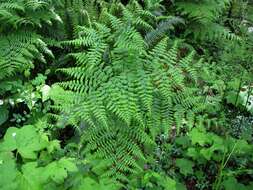Northern bracken, BrackenNative to nw Canada and nw United States, as well as other areas.Dennstaedtiaceae (Bracken family)Photo: Vancouver, British Columbia, CanadaFrond
www.flickr.com/photos/dweickhoff/8870636169/in/photolist-...Bracken has been used throughout in many cultures around the world. The fiddlehead (immature unfurled fronds) are bitter, but used fresh, cooked, or preserved by pickling, salting, or sun drying. For example, in Korea, called gosari, they are used in bibimbap or gosari-namul, a sauteed side dish; and as a vegetable dish in Japan, called wasari.Native Americans pound the rhizomes in making a stachy flour for bread; and in Japan used a starch to make confections.In Hawaii, klau is collected and use in wasari. But, according to one source, "because bracken fern has cancerous properties and a nerve poison, it should be eaten infrequently and in moderation."EtymologyThe generic name Pteridium is derived from the Greek pteris, fern, and pteron, wing or feather, in reference to fronds suggesting the spread wings of a bird.The specific epithet aquilinum, is Latin for eagle (Aquila).The varietial name decompositum is from the Latin de, very, and compositus, compound, in reference to the frond division.The Latin subspecific lanuginosum, indicates a woolly or cottony covering, like wool, lana, lanae.



